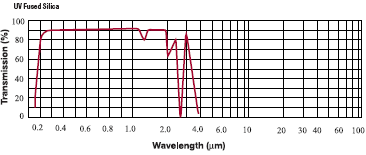
 |
|
|
| Ultiquest Technology is capable of fabricating a wide variety of optical components with various optical materials. The most important material properties to consider for an optical element are transmission versus wavelength, index of refraction, thermal characteristics, mechanical and chemical characteristics and cost.
To select the right materials seems overwhelming. The simplest way is to let Ultiquest Technology engineers know your applications, and we select them for you. |
| |
 Borosilicate Crown Glass (BK7)-------------------------------- Borosilicate Crown Glass (BK7)-------------------------------- |
|
|
 Borosilicate Crown Glass is used for windows, lenses, and prisms where transmission in the range 0.4¦Ìm to
1.4¦Ìm is desired. The refractive index varies from about 1.53 to 1.5 through this range. It is used for thermally
non-critical applications. Borosilicate Crown Glass is used for windows, lenses, and prisms where transmission in the range 0.4¦Ìm to
1.4¦Ìm is desired. The refractive index varies from about 1.53 to 1.5 through this range. It is used for thermally
non-critical applications. |
|
| Property |
Specification |
| Transmission Range |
0.4-2.5¦Ìm |
| Density |
2.51 g/cc |
| Thermal Expansion Coefficient |
7.1x10-6/¡ãK @ -30¡ã to +70¡ãC, and 8.3x10-6/¡ãK @ 20¡ãC to 300¡ãC |
| Surface Finish |
BK7 polishes extremely well and polishes of 10-5, or 20-10 scratch-dig are
achieved at extra costs respectively, mainly for UV and visible applications. |
| Surface Figure |
Surface figure of 1/10 wave to 1/4 wave @0.6328¦Ìm are specified mostly on lenses
for ultraviolet and visible use. |
| AR Coating Options |
AR @ 0.8-2.5¦Ìm, AR @ 1.064, AR @ Visible W.L. |
| Typical Applications |
Astronomical, Thermal Imaging |
| Products Manufactured |
Lenses, Windows, Wedges, Prism, BeamSplitters, Filters. |
|
|
|
|
|
 Optical
Transmittance Curve of BK7 (Reference Data): Optical
Transmittance Curve of BK7 (Reference Data): |
|
 |
|
|
|
 Fused Silica (UV Grade)------------------------------------- ----- Fused Silica (UV Grade)------------------------------------- ----- |
|
 Fused silica is often used in near infrared systems performing in the 0.8-2.5¦Ìm spectral region. It is also
frequently used at the popular 1.064¦Ìm Nd:YAG laser wavelength. Fused silica is often used in near infrared systems performing in the 0.8-2.5¦Ìm spectral region. It is also
frequently used at the popular 1.064¦Ìm Nd:YAG laser wavelength.
The material has high homogeneity and good transmission in the visible and near infrared spectral regions.
Cost of the material ranges widely by type and purity. However the most common Fused Silica for infrared
use is quite a bit more expensive than Silicon and slightly less expensive than Calcium Fluoride or ZnS
Multi-spectral grade. Due to the materials inherently hard SiO2 amorphous structure, the material is not
diamond turnable. Typical specifications for surface quality in the near infrared regions are a 40-20 scratch dig. |
|
| Property |
Specification |
| Transmission Range |
0.18¦Ìm to 2.5¦Ìm |
| Density |
2.202g/cm3 |
| Thermal Expansion Coefficient |
5.5x10-7 / ¡ãC@20 to 320¡ãC |
| Surface Finish |
Fused Silica polishes extremely well and polishes of 10-5, or 20-10 scratch-dig are
achieved at extra costs respectively, mainly for UV and visible applications. |
| Surface Figure |
Surface figure of 1/10 wave to 1/4 wave @0.6328 ¦Ìm are specified mostly on lenses
for ultraviolet and visible use. |
| AR Coating Options |
Typical available infrared coatings are a BBAR from 0.8- 2.5 ¦Ìm and an AR coating
for 1.064 ¦Ìm wavelength. |
| Typical Applications |
Thermal imaging, Astronomical,Microlithography, Excimer laser applications,
Nd:YAG laser applications. |
| Products Manufactured |
Lenses, Windows, Wedges, Prism, BeamSplitters, Filters. |
|
|
|
|
|
 Optical
Transmittance Curve of UV Fused Silica (Reference Data): Optical
Transmittance Curve of UV Fused Silica (Reference Data): |
|
 |
|
|
|
 Fused Silica (IR Grade)------------------------------------- ----- Fused Silica (IR Grade)------------------------------------- ----- |
|
|
 Fused silica is often used in near infrared systems performing in the 0.8-2.5¦Ìm spectral region. It is also
frequently used at the popular 1.064¦Ìm Nd:YAG laser wavelength. Fused silica is often used in near infrared systems performing in the 0.8-2.5¦Ìm spectral region. It is also
frequently used at the popular 1.064¦Ìm Nd:YAG laser wavelength.
The material has high homogeneity and good transmission in the visible and near infrared spectral regions.
Cost of the material ranges widely by type and purity. However the most common Fused Silica for infrared use
is quite a bit more expensive than Silicon and slightly less expensive than Calcium Fluoride or ZnS Multispectral
grade. Due to the materials inherently hard SiO2 amorphous structure, the material is not diamond
turnable. Typical specifications for surface quality in the near infrared regions are a 40-20 scratch dig. |
|
| Property |
Specification |
| Transmission Range |
0.25¦Ìm to 3.5¦Ìm |
| Density |
2.202g/cm3 |
| Thermal Expansion Coefficient |
5.5x10-7 / ¡ãC@20 to 320¡ãC |
| Surface Finish |
Fused Silica polishes extremely well and polishes of 10-5, or 20-10 scratch-dig are
achieved at extra costs respectively, mainly for UV and visible applications. |
| Surface Figure |
In the infrared, typical surface figure ranges from 1/4 wave to 2 waves @0.6328¦Ìm
and are specified depending on the system performance requirements. |
| AR Coating Options |
Typical available infrared coatings are a BBAR from 0.8- 2.5¦Ìm and an AR coating
for 1.064¦Ìm wavelength. |
| Typical Applications |
Thermal imaging, Astronomical,Microlithography, Excimer laser applications,
Nd:YAG laser applications. |
| Products Manufactured |
Lenses, Windows, Wedges, Prism, BeamSplitters, Filters. |
|
|
|
|
 Optical
Transmittance Curve of IR Fused Silica (Reference Data): Optical
Transmittance Curve of IR Fused Silica (Reference Data): |
|
 |
|
|
|
|
 Contact Contact
If you have any questions or comments, please contact us by filling-in the mail form.
|
|
|



